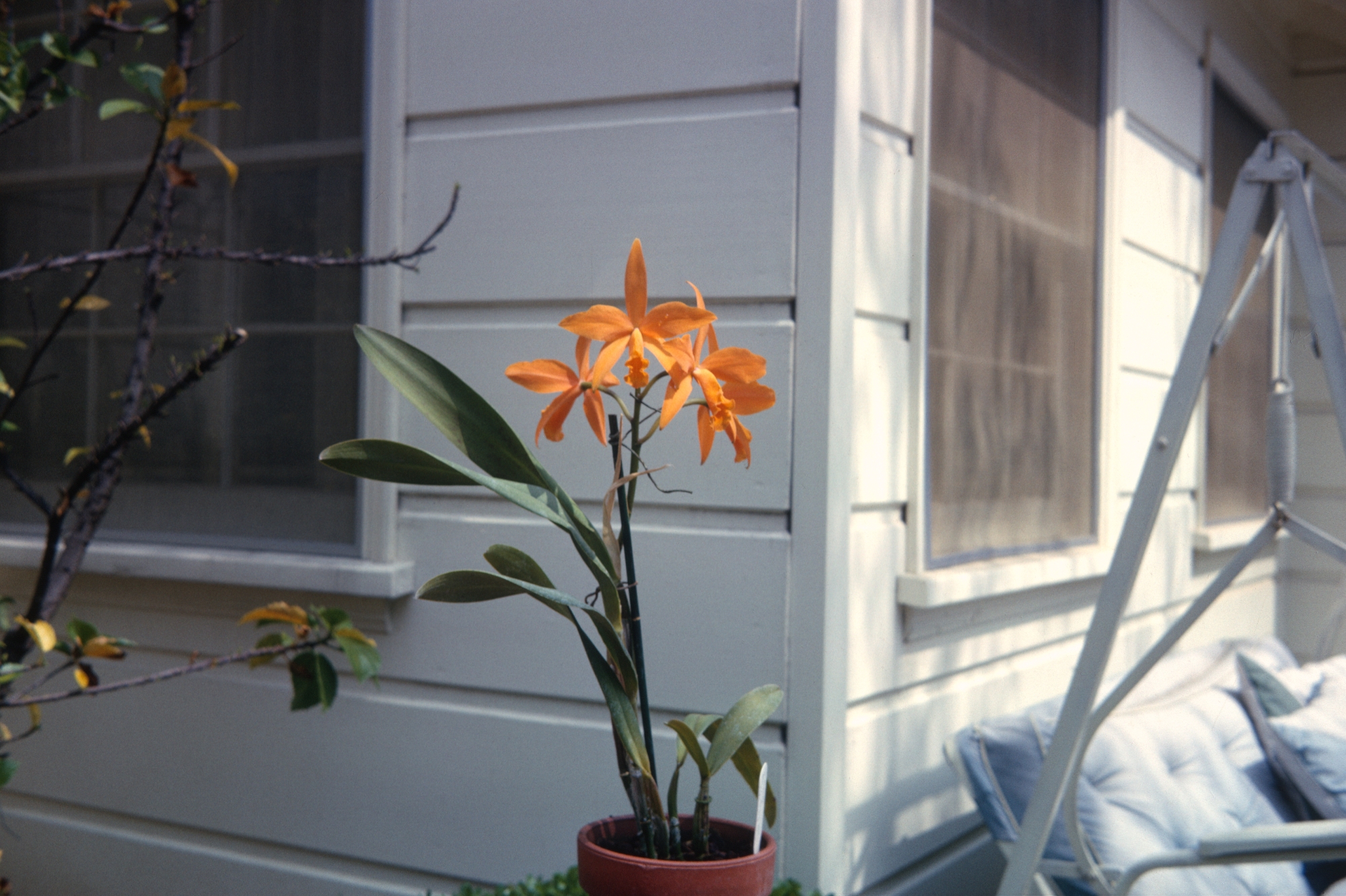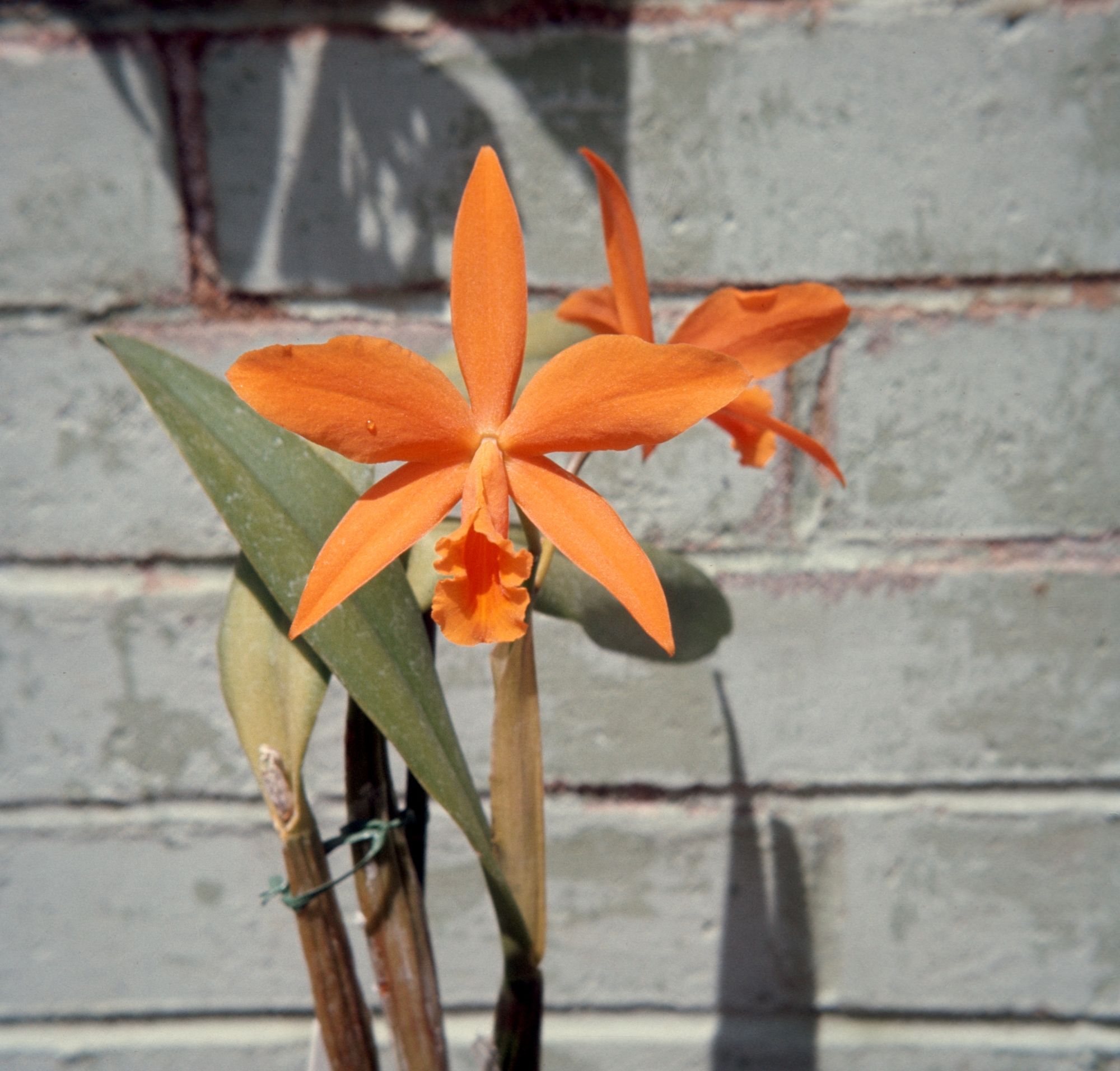Kay Francis Photo Gallery: Lc. Orange Gem
Parentage: Lc. Elinor × Lc. G. S. BallCurrent nomenclature: Cattleya Orange Gem (1929)
The hybrid in question is now known as Cattleya Orange Gem (1929), derived on both sides from Laelia (now Cattleya) cinnabarina (and on one side, also L. (now C.) harpophylla) and C. shroederae. There are photos of a cultivar 'Delight' in OrchidWiz and elsewhere, but the stated parentage of that plant seems surprising — the flowers in the photo are not as "true" orange as expected (more red), and they look very much like one of Kay's Potinaras, such as Candy Kisses! The one awarded cultivar of Orange Gem from America, 'Naranja', received HCC/AOS and HCC/ODC at the 1962 Santa Barbara International Orchid Show, but no descriptions were published for HCC awards at that time. No photos were published either in the AOS Bulletin or Orchid Digest, and no AOS award slide has been found.
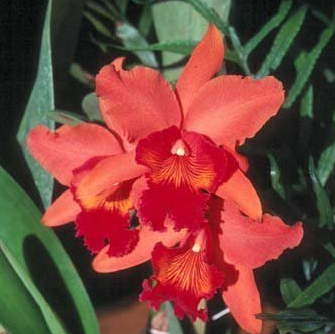
Image #56367 from OrchidWiz, identified as Lc. Orange Gem 'Delight', attributed to the Steve McNerney collection. At least in this image, it looks very much like a one of Kay's Potinara hybrids!
However, the cultivar 'Delight', represented by several photographs, requires more discussion. The grex is discussed at length (but solely on the basis of this one cultivar) in the AOS Bulletin 62(11):1126-1133 (November, 1993) in an article by Roger Cole and Plato Mathews, "The Baroness Shroder's Cattleya". While the article discusses 'Delight' ("the best clone out of this line", ... "while it is still star-shaped, it has 5-inch orange flowers well presented on fine spikes" — not a plausible description of the photo of 'Delight' in OrchidWiz!), the accompanying images in the article are misidentified. One photo, identified as Lc. Elinor 'Isaacs', supposed to be one of the parents of Orange Gem, is instead the award photo of the very different hybrid Lc. Elinor Isaacs 'Blue Grass', and the photo is on the right side, not the left as indicated, on p. 1128 — the misidentified and misplaced photo is a mirror image of the black-and-white version of the award photo for 'Blue Grass' from 1962, published in the Register of Awards Suppl. IV p. 623! The other photo on p. 1128 — from the text, apparently a misplaced photo of Blc. Iliad — is recognizably the 1961 AOS award photo of Iliad 'Walmac', but here rendered much too dark, almost brick red. The photos on p. 1129 are likewise reversed, Pot. Lemon Tree 'Stuart' (left, not right) and Slc. Paprika 'Cayenne Ruby' (right, not left). And, in spite of the extended discussion, the article does not include a photo of any cultivar of Orange Gem.
76.jpg)
© 1998 Orchid Digest ex Fred A. Stewart, Inc.
Lc. Orange Gem 'Delight', from Orchid Digest article by Ernest Hetherington, photo attributed to Stewart's Orchids
A photo of 'Delight' was published in Orchid Digest 62(2):76 (April, 1998), in an article by Ernest Hetherington, "A matter of taste—From Trick or Treat to Orange Crush: The breeding of orange Cattleyas". Here the origin of 'Delight' is revealed: Hetherington obtained it "as a seedling from the H. G. Alexander's nursery and [it] was given its cultivar name by the author". There is also a second photo of 'Delight' in OrchidWiz (image #192472, attributed to Plato Peter Matthews), apparently the same cultivar, but the photo shows a flower that is more plausibly orange and with a more open form, still hard to square with the description of 5" star-shaped flowers and the stated parentage. We show the image from Orchid Digest here (right) — the clearest published photo for assessing the form of this cultivar, even though the color is surely over-saturated.
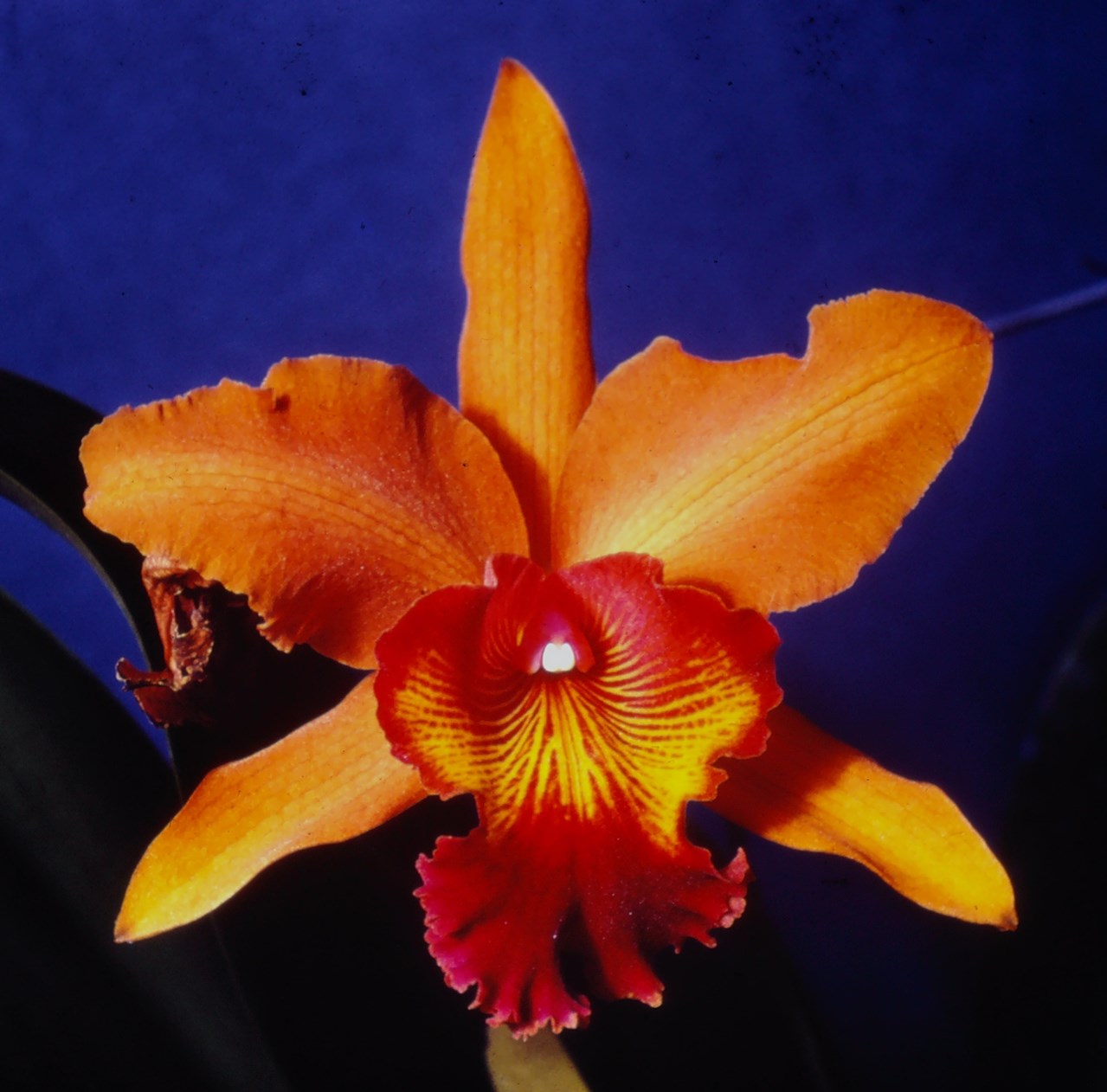
Lc. Orange Gem 'Delight', from Fordyce archive
A "duplicate" of the original slide was found in the Fordyce slide archive at the Huntington Botanical Center, dating from November, 1967, without other information or attribution, certainly the best illustration of 'Delight'.
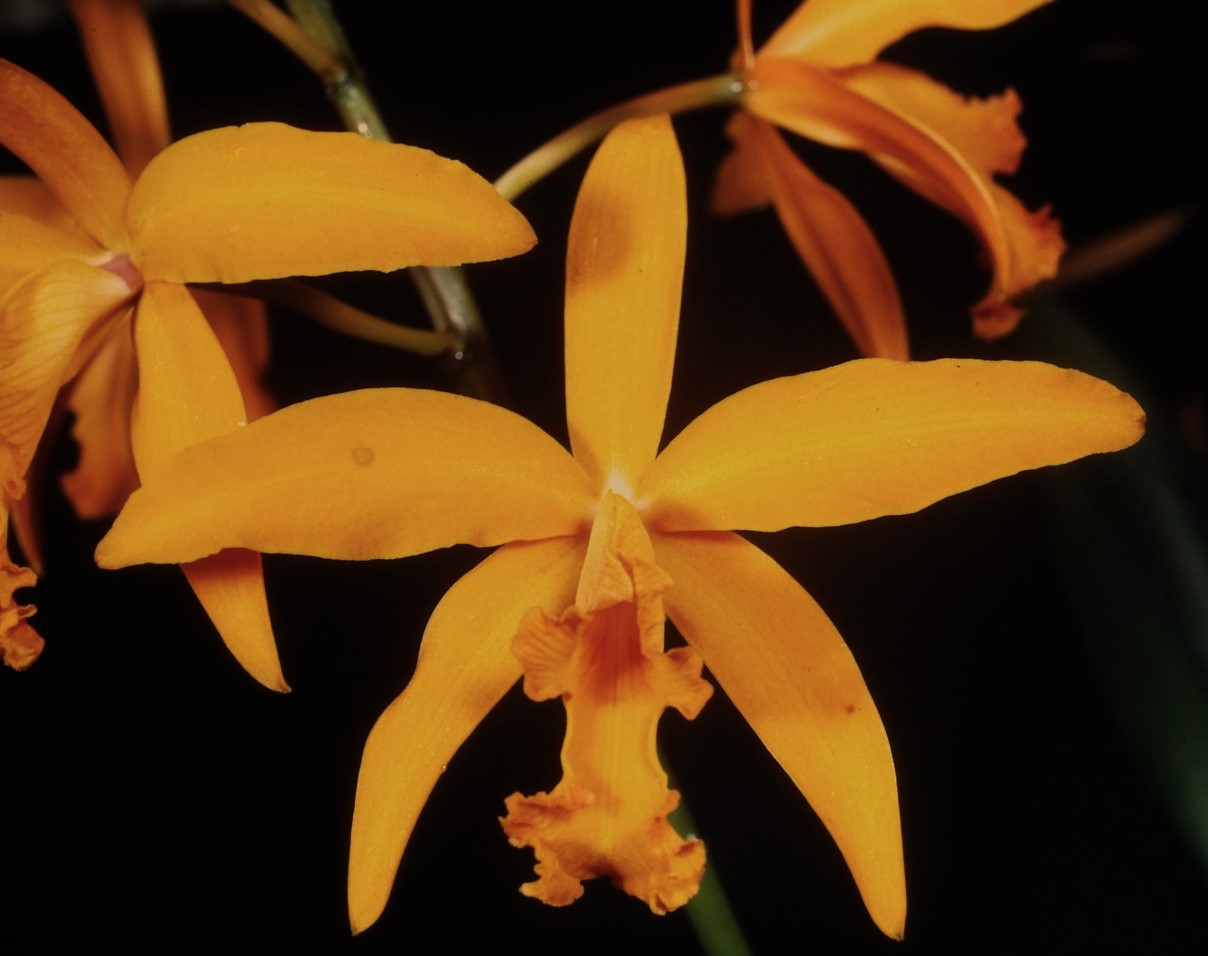
Lc. Elinor 'True Orange' HCC/AOS, new scan from Pacific South award slides, exhibited at Long Beach monthly judging by Fred A. Stewart, Inc.
The parents of Orange Gem, registered in 1929 by H. G. Alexander, are Lc. Elinor and Lc. G. S. Ball. Kay obtained her Orange Gem from Stewart's, apparently in June or July of 1957, but it was clearly not their 'Delight' (KF VII / A / 2 p. 20). In any case, the only verifiable photo of Lc. Elinor (not the spurious photo that is actually Lc. Elinor Isaacs) from American sources is of Stewart's cultivar 'True Orange' (left). There are several photos of Lc. G. S. Ball in OrchidWiz, all generally orange, some with stronger red tones in the lip, all distinctly "star-shaped", but with somewhat fuller petals than Elinor. Kay's Orange Gem, whatever its origin and cultivar name, is consistent with this parentage, while the plant shown in the published photo of 'Delight' seems anomalous. As 'Delight' seems never to have been awarded, there are no other measurements or descriptions for comparison with the photos.
Another source for "typical" images of Lc. Elinor, Lc. G. S. Ball, and Lc. Orange Gem is the award paintings from the Royal Horticultural Society. The CD edition of the RHS orchid awards issued in 2003 includes Nellie Roberts' paintings of Lc. Elinor (1908), two cultivars of Lc. G. S. Ball (1900, 1905, the latter, 'Magnifica', significantly more red than the plain orange of Elinor and the 1900 cultivar of G. S. Ball, and with more erect petals), and two of Lc. Orange Gem (1936, and 1976, the latter painted by Iris Humphries, much redder). Except as noted, all of these have essentially the same medium orange color (some with reddish highlights) and the same shape (very open form, long, narrow, ruffled lip like that of Kay's plant, and petals drooping below the horizontal). 'Delight' is certainly exceptional, and Kay's plant is more typical of the available examples of the grex and its parents, and with more symmetrical form (tepals forming a near-perfect five-pointed star).
In attempting to resolve these inconsistencies, we have to acknowlege the exasperation that results from discovering misidentified photos in many issues of the AOS Bulletin and in the AOS awards database. The growing collection of color slides from the "Greatest Generation" of Southern California orchid growers in the "orchid archive" at the Huntington Botanical Center presents an opportunity to expand the photographic record and, eventually, to correct it. Better and more accessible digital images of the RHS award paintings would help as well.


